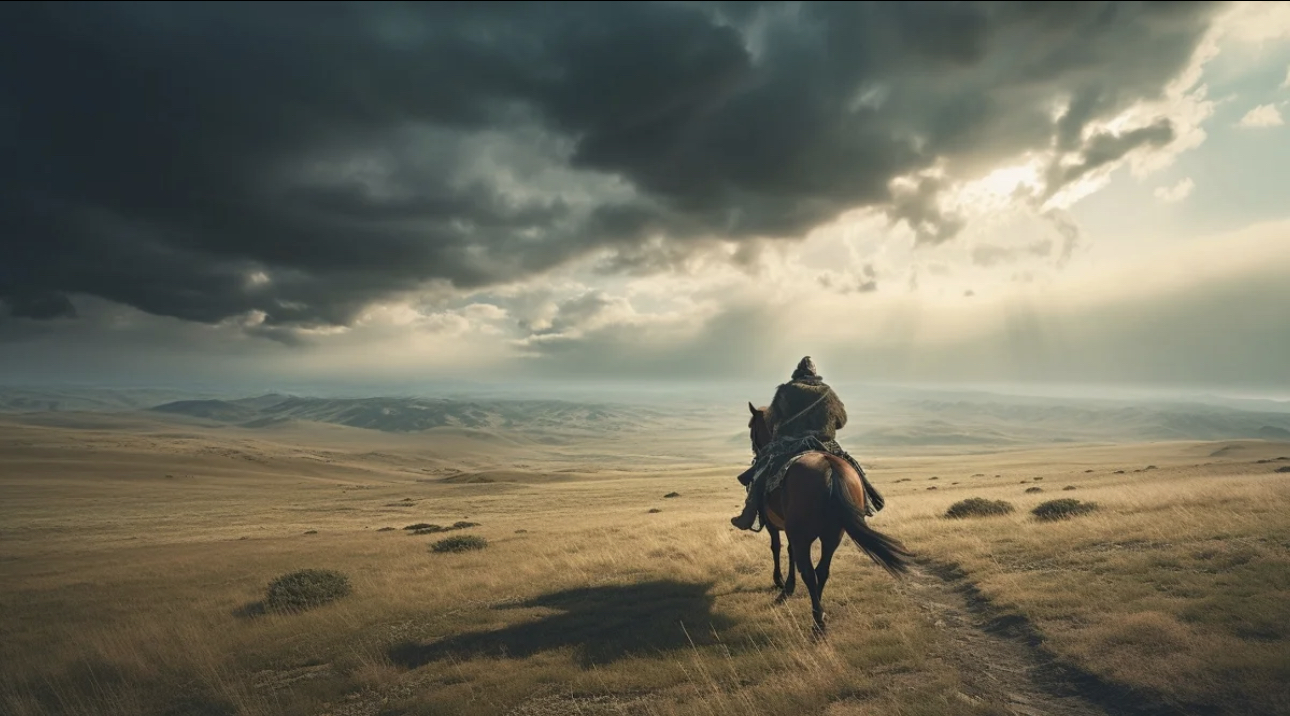ASTANA – Nearly 800 years after the man called Genghis Khan forged a vast empire stretching from the Pacific Ocean in the east to the Caspian Sea in the west, the Mongol emperor’s conquest story continues to fascinate historians and the public alike. According to historian Artem Porsin, his expansion into the steppes of what is now Kazakhstan was driven by politics, economics, and even environmental factors.

Photo credit: Midjourney
Porsin explained that, given the political landscape of the time, with the powerful Merkit and Naiman tribes in the west posing a serious threat to the Mongol empire, Genghis Khan’s campaign was a necessary act of defense and consolidation.
“Genghis Khan had serious rivals in the steppe, primarily the Merkits and Naimans, whom he drove out of Mongolia. They fled westward to the Kazakh steppes. Therefore, as long as these tribes remained independent and retained their combat capability, the Mongols could not feel secure and develop a long-term policy in Mongolia itself, including in relation to China,” Porsin told Kazinform news agency.
For instance, in 1215, Genghis Khan was compelled to halt his campaign to conquer northern China and return westward after the threat from the Merkit and Naiman tribes grew increasingly severe.
“Until they were destroyed or conquered, Genghis Khan could not develop any long-term policy. That is why, in 1217, the Mongols began a large-scale advance to the west. The initial goal was to defeat the Merkits and Naimans and occupy the territories of the Kazakh steppes from the Yertis to the Zhayik [rivers]. Already in the process of this, the war with the Khorezm empire began,” Porsin said, referring to a state located in present-day Central Asia, Afghanistan, and Iran.
From an economic standpoint, the primary source of wealth for both the Mongol Empire and the Khorezm Sultanate, already at war by 1219, was the revenue generated from caravan trade routes. Control over these vital corridors connecting China with the West brought immense economic benefits. However, as Porsin said, securing these routes was challenging and impossible without first subjugating the northern steppes.
The third factor was demographic and ecological. The expansion of the Mongol empire was closely tied to climate change, specifically, the moistening of the steppes that began in the late 12th century. This wetter climate boosted vegetation across the steppes, leading to a rapid rise in livestock numbers and, consequently, population growth. As the nomads’ herds and communities expanded, so too did their need for new pastures and territory.
In 1217, Genghis Khan’s eldest son, Jochi, set out with his horde to conquer the nomadic steppes. This was not merely a campaign to defeat the Merkit and Naiman tribes, but also an effort to secure the region that would later form the Ulus of Jochi.
“The conquest of the steppe region played a huge role in the further development of the Ulus of Jochi, as he received the most extensive steppe territory. The Ulus of Ugedei and Shagatai [Gengiz Khan’s younger sons] received rich lands with developed urban culture, but it was the steppe resources that largely went to Jochi and his descendants,” said Porsin.

Artem Porsin. Photo credit: Porsin’s personal archive
What happened to the nomadic tribes after the conquest?
The nomadic population was not destroyed but instead became a part of Genghis Khan’s empire. The ulus system created the foundation for uniting various tribes that would eventually form the Kazakh Khanate. Many tribes, such as Kangly, Kipchak, and Naiman, retained their names up to this day.
Overall, the Turkic-Mongolian population was not erased but reorganized into a new political and social structure, divided among different uluses, with the majority becoming part of the Ulus of Jochi.
“It is difficult to speak of a sharp change in culture in the steppes after Genghis Khan’s conquests, but it can be said with certainty that an active process of Islamization began as early as the 14th century. The appearance of burials changed: Muslim graves appeared, replacing earlier forms,” said Porsin.
“But we can talk about changes in the culture of the ruling class. Before the conquest, the steppes from the Yertis to the Danube [rivers] were occupied by the Kipchaks, Kangals, Yemeks, and other tribal associations. Apparently, there was a significant change in the elite of the nomadic groups. For example, a distinctive cultural feature, the famous Polovtsian stone sculptures found on the burial mounds of the nobility, vanished completely. These monuments were widespread during the 11th and 12th centuries but disappeared abruptly in the 13th century. This, it seems, was linked both to a partial shift in the ruling elite and to broader cultural changes,” Porsin said.
The article was originally published on Kazinform.